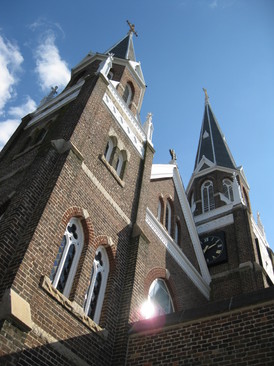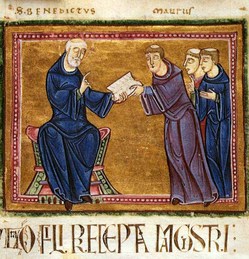A great example of religious freedoms being trampled is what’s happening with Belmont Abbey College. This is exactly what Archbishop Dolan and Bishop Lori are working on with the new Ad Hoc Committee of the USCCB on Religious Freedom (see previous posts linked on the right).
Tag: Belmont Abbey
Catholic Apologetics Summer Camp sponsored by the Envoy Institute & Belmont Abbey College
Come enjoy deepening your faith and learning how to better defend it from some of America’s leading Catholic apologists, while having a blast in the great outdoors in a setting that’s close to heaven: nestled in the Pisgah National Forest in the Blue Ridge Mountains of North Carolina. (Go to www.2FunCamps.com to check out our gorgeous conference site. Boys and girls will sleep in separate camps, but will be together during the day.)
tree.
Belmont Abbey & College host Eucharistic gathering
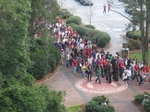 On the 5th Sunday of Lent (March 29) the Charlotte diocese co-sponsored with Belmont Abbey & College the 3rd annual Eucharistic Congress for Youth. The gathering included a procession with the Eucharist around the campus, inspirational and formative talks, the sacrament of Confession, Vespers and Benediction. Bishop Peter Jugis, Abbot Placid, Dom Kieran and Dom Edward, among other monks and religious, including 2 Capuchin friars, assisted in giving a witness to the exceptional and powerful Presence of the Lord with more than 450 students from the college and across the diocese.
On the 5th Sunday of Lent (March 29) the Charlotte diocese co-sponsored with Belmont Abbey & College the 3rd annual Eucharistic Congress for Youth. The gathering included a procession with the Eucharist around the campus, inspirational and formative talks, the sacrament of Confession, Vespers and Benediction. Bishop Peter Jugis, Abbot Placid, Dom Kieran and Dom Edward, among other monks and religious, including 2 Capuchin friars, assisted in giving a witness to the exceptional and powerful Presence of the Lord with more than 450 students from the college and across the diocese.
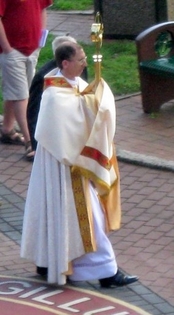 This terrific Eucharistic event strengthened and gave hope to the many participants. Plus, it was a spectacular sunny day. It was a keen reminder that all of life is viewed through the lens of the Eucharist.
This terrific Eucharistic event strengthened and gave hope to the many participants. Plus, it was a spectacular sunny day. It was a keen reminder that all of life is viewed through the lens of the Eucharist.
The gaze of the Eucharistic Lord on us and us on Him is a beautiful gesture of mercy.
Read the story here.
Anniversary of the Dedication of Belmont’s Abbey Church
This place was made by God, an inestimably holy place. It is without reproof.
Most people are accustomed to celebrating anniversaries: wedding, ordination, religious profession, moving to a new place, etc. From time immemorial the Church has celebrated the anniversary of a church’s dedication; there are notable examples of this in the liturgical calendar, e.g., Dedication of the Lateran Basilica. Today, in the life of the Diocese of Charlotte and the monks of Mary Help of Christian – Belmont Abbey, the Abbey Basilica is honored because of it consecration in 1965 by Abbot Walter Coggin, abbot nullius. Dom Agostino celebrated the conventual Mass. The wonderful drama of the Liturgies since first Vespers last evening has been the 12 dedication candles lit. They are rearely lit even in the most liturgically sensible places that seeing them glow is just wonderful. Wouldn’t it be a good thing if pastors lit the dedication candles on all the feasts of the Lord and the feasts of the apostles!
In 1892 Abbot-Bishop Leo Michael Haid blessed and laid the cornerstone for the abbey church which in time became the cathedral for the Apostolic Vicariate (founded in 1910). This church had two significant uses: it was the church in which the monks daily prayed and it was the heart of Catholic life for the state of North Carolina. According to the monks, the cathedral was only blessed in the 19th century because there was a mortgage and it had a wooden altar. The cathedral was renovated in 1964-65 and it needed to be properly consecrated which was done on this date in 1965. As history would have it, the abbey church was still the cathedral but by 1960 the territory had been reduced to the land on which the abbey and cathedral sat. The Diocese of Raleigh had been established in 1924 and preparations for the erection of the Diocese of Charlotte were on the way, ultimately coming in 1972.
The point of the festive Mass on such an anniversary and the use of special antiphons used in the Divine Office is honor God by keeping sincere our worship in the saving love of this church. It is also a keen reminder that we find our refuge in the Lord while praying in spirit and truth.
Some points from recent ecclesial documents may help focus our attention on the meaning of the Church:
The church building is a sign and reminder of the immanence and transcendence of God –who chose to dwell among us and whose presence cannot be contained or limited to any single place. …Churches are signs of the pilgrim church on earth; they are images that proclaim the heavenly Jerusalem. (Built of Living Stones, no. 50)
The dedication of a church, especially a cathedral, is a significant and rare event in the life of a Christian community. It involves more than merely setting aside a building for the celebration of sacred things, since the people who plan, build, and dedicate a sacred
place are themselves the Church, “that is, the temple of God built of living stones, where the Father is worshiped in spirit and in truth. Rightly, then, from early times the name ‘church’ has also been given to the building in which the Christian community gathers to hear the Word of God, to pray together, to celebrate the Sacraments, and to participate in the Eucharist.” (Rite for the Dedication of a Church and an Altar, chapter 2, no. 1); this building is both the house of God on earth (domus Dei) and a house fit for the prayers of the saints (domus ecclesiae). (Built of Living Stones, no. 16).
In the end, the text from a hymn used at a church’s dedication speaks volumes:
O how amiable are thy dwellings: thou Lord of hosts!
My soul hath a desire and a longing to enter into the courts of the Lord:
My heart and my flesh rejoice in the living God.
Yea, the sparrow hath found her a house,
and the swallow a nest where she may lay her young:
even the altars, O Lord of hosts, my King and my God.
Blessed are they that dwell in thy house: they will be always praising thee.
The glorious Majesty of the Lord our God be upon us:
prosper thou the work of our hands upon us.
O prosper thou our handywork, O prosper thou our handywork.
O God our help in ages past, Our hope for years to come,
Our shelter from the stormy blast, And our eternal home.
(Text Psalms 84 & 90; Isaac Watts (1674-1748)
88th anniversary of death of James Gibbons, cardinal
James Cardinal Gibbons
Archbishop of Baltimore
Cardinal Priest of Santa Maria in Trastevere
30 June 1861, ordained priest
3 March 1868, Vicar Apostolic of North Carolina & later ordained bishop
30 July 1872, bishop of Richmond
20 May 1877, archbishop of Baltimore
7 June 1886, created cardinal
24 March 1921, died
Of the many things the Cardinal arranged for the possession by the Benedictines of Caldwell Place, Gaston County, North Carolina, on which Mary, Help of Christians – Belmont Abbey sits. He also ordained Abbot Leo Michael Haid, a bishop and arranged for him to be the vicar apostolic of North Carolina. Haid prayed one of the absolutions for the Cardinal at his funeral. The monks of Belmont Abbey remembered the Cardinal at Mass.
Sun and Seed
Weather-wise, the day was spectacular. The day was spent at the modest lake house the abbey has had for many years on Lake Norman, just north and west of Belmont Abbey. Among many things the five of us did together today was to plant grass seed to cover the bare spots in the “lawn.” The day away also afforded us the opportunity to foster the companionship and devotion (to the Lord): we prayed the Office of Sext and had lunch. By the way, are you aware that a bale of straw costs $4.75? I think it’s a little expensive for straw! But I suppose the farmer is worth his wage.
Brother Anthony was tired of sowing seed so he showed the inspirational video “The Everyday,” a narrative about the monkish life at Mount Savior Monastery in New York state. Mount Savior was founded in 1950 by Father Damasus Winzen in order to live a monastic life without an outside work like a school or parish and to be most devoted to the Divine Office.
In all the day was a nice getaway with confreres. And let’s hope that it rains soon and that the birds don’t get fat on the seed.
Enticing things to grow with nature to help (at the abbey)
Spreading…makes life more interesting, or a least it makes the flowers grow. Yesterday Gail, the abbot’s administrative assistant, brought me a gift, a token of appreciation. Well, I requested it so it’s technically not a gift. Gail brought me a feed bag of mature horse manure from her own horses; it’s mature manure I am assured. I got a phone call from Brother Anthony saying that I had a bag of … manure on the front steps. Not wanting to offend guests I quickly moved the bag to the Saint Francis garden.
Before the night rain fell and after vespers but before the total loss of daylight, I made a mad-dash to the garden to spread the “garden tea.” I couldn’t help but remember -and laughing riotously– at what a senior Jesuit friend of mine said of Jesuits and horse manure: if you keep Jesuits together they stink; if you spread them around, they fertilize. I think you get the point. Besides hoping for the cooperative intercession of Saint Francis, I am expecting the manure to heighten the garden’s capacities.
Much of last week I had my friend Brother Michael visiting me. It was nice to have him here. As it is said, “Hospes venit, Christus venit.” A stranger comes, Christ comes. This saying is part of the Rule of Saint Benedict and we often find it on signs at Benedictine monasteries: “Let every stranger be received as Christ himself.” Brother Michael is not a stranger to me but he was to members of the community for a very short time. The others we edified by his presence and I got a chance to share life with a friend.
Last Saturday we had the privilege of welcoming back to the Abbey and the College Father Dwight Longenecker, an Oblate of Saint Benedict, to speak to interested parties on Saint Thérèse of Lisieux and her “little way” as a fitting approach to living Lent. His blog, Standing on My Head is a popular read.
These last days have been interesting and boring at the same time. More painting is taking place. This time we’re doing the Compline room, the place where Night Prayer is prayed; it badly needed some fresh paint on the walls. We also did some garden work in a neglected area of the monastery gardens and we did some odds-and-ends.
One of the postulants decided to leave the abbey thus ending his discernment in following a monastic vocation. Mary, Help of Christians – Belmont Abbey is much the poorer. Andrew is 24 and a recent grad of Belmont Abbey College and Saint John’s in Annapolis. We wish him well and many blessings.
My fun reading this week is a book on the Solesmes and Dom Gueranger: 1805-1875 (Paraclete Press, 1996).
 Life in a monastery is fun. Oh, yea, the flowering trees are working hard to push out the color!!!! AND now I need more manure.
Life in a monastery is fun. Oh, yea, the flowering trees are working hard to push out the color!!!! AND now I need more manure.
Saint Katharine Drexel
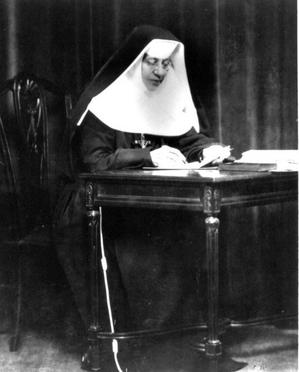 The outline of Katharine Drexel’s life is:
The outline of Katharine Drexel’s life is:
Born in Philadelphia, PA on Nov. 26, 1858
First sister to profess vows as a Sister of the Blessed Sacrament on Feb. 12, 1891
Died on March 3, 1955
Beatified on Nov. 20, 1988
Canonized on Oct. 1, 2000
With the Church we pray,
Ever-loving God, You called Saint Katharine Drexel to teach the message of the Gospel and to bring the life of the Eucharist to the African American and Native American peoples. By her prayers and example, enable us to work for justice among the poor and the oppressed, and keep us undivided in love in the eucharistic community of Your Church.
Saint Katharine’s connection to Maryhelp – Belmont Abbey is that she used a portion of her personal wealth to help build a number of churches, including the abbey church, for the first abbot of Maryhelp, Abbot-bishop Leo Haid. She also visited the abbey. So, we can say that a saint walked on this soil! A sign in the Abbey Basilica narthex commemorates this fact. May Saint Katharine continue to intercede for us and help us to know the Lord.
Saint Walburga
O God, the boundless generosity of your favor is proclaimed by the wonders you have worked in your holy women. As we are taught by your holy virgin Walburga’s example of purity and rejoice in the glory of her miracles, may she be our patron to gain for us your unfailing love.
One of the important Benedictine saints in the Church is the 8th century Saint Walburga and yet she is relatively unknown to many outside the world of monks and nuns. Her story is found here. You might find it interesting to note that Saint Walburga’s relative is the Apostle to
In
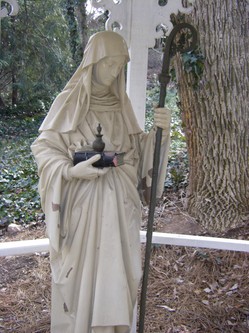 Since 1857, the Benedictine sisters of Elizabeth, NJ, also claim Saint Walburga as their patron.
Since 1857, the Benedictine sisters of Elizabeth, NJ, also claim Saint Walburga as their patron.
Also, we should mention the venerable witness of Saint Walburg Monastery in
Belmont Abbey’s secondary patron is Saint Walburga. No fewer than two statues, one in the monastery and one in the grotto honor the saint. Plus, the monks honored the saint with a beautiful stained glass window in the Abbey Basilica.
The novena prayer to Saint Walburga
Holy Walburga, you dwell in the glory of heaven, gazing upon the face of the Triune God in the company of all the saints. I turn to you, full of trust in the words of Jesus Christ, “Amen, amen I say to you, the one who has faith in me will do the works I do, and greater far than these” (John
Ask this for me through Jesus Christ, our Lord, who lives and reigns in the unity of the Father and the Holy Spirit, one God for ever and ever. Amen.
Silence: in the Christian life and not just for the monks
Silence in the monastery confuses the world; it sometimes confuses me and there are times that I am frustrated by silence. The practice of silence is often misunderstood by those who live in monasteries because of an insufficient understanding of a “theology of silence.” Family and friends think monks take a vow of silence. They get this idea from the clichés of the TV and movies where they see monks and nuns piously walking the halls of the abbey in silence with a mean looking superior hovering over the shoulder waiting for someone to slip-up. While I don’t deny that this understanding may be rooted in some truth, or a least a vague sense of truth, it nonetheless lends itself to gross misunderstanding of the role of silence in the monastic life, indeed the need (and desire for) for silence in all people’s lives.
What did Saint Benedict say about the practice of silence in his Rule? In one place he says:
Let us do what the Prophet says: “I said, I will take heed of my ways, that I sin not with my tongue: I have set a guard to my mouth, I was dumb, and was humbled, and kept silence even from good things” (Psalm 38[39]:2-3). Here the prophet shows that, if at times we ought to refrain from useful speech for the sake of silence, how much more ought we to abstain from evil words on account of the punishment due to sin.
Therefore, because of the importance of silence, let permission to speak be seldom given to perfect disciples even for good and holy and edifying discourse, for it is written: “In much talk up shall not escape sin” (Proverbs 10:19). And elsewhere: “Death and life are in the power of the tongue” (Proverbs 18:21). For it belongs to the master to speak and to teach; it becomes the disciple to be silent and to listen. If, therefore, anything must be asked of the Superior, let it be asked with all humility and respectful submission. But coarse jests, and idle words or speech provoking laughter, we condemn everywhere to eternal exclusion; and for such speech we do not permit the disciple to open his lips (Ch. 6).
Belmont Abbey’s Father Abbot, Placid, put in our mailboxes the community’s custom of silence that had been formulated in consultation with the community in 2006. Essentially it is outlines what’s permitted and what’s not. To me, it is less of a “wagging of the finger” as it is a way to focus our life yet again on a venerable practice that leads to freedom but yet takes discipline and freedom to engage our mind, hear and will. So what’s expected? Following Vespers (c. 7:30 pm) to the conclusion of breakfast (c. 8:00 am) silence is carefully observed throughout the monastery. Extended conversations may be had in designated areas like the common recreation areas, the formation study and the guest dining room. “A spirit of silence should be maintained in the hallways of the monastery at all times, and any conversation should be carried on in a quiet tone of voice.” Another place where we attempt to maintain silence is in the sacristy, the basilica and in the passage way between the abbey and the basilica. A stricter sense of being silent exists in the church prior to the Mass and the Divine Office, in the refectory before the evening meal which includes the brief reading of a chapter (a few lines really) of the Rule of Saint Benedict and during table reading (only 15 min.) and in “statio” (the order of seniority) prior to Sunday Mass and Vespers.
This work of silence is neither rigid and nor is unreasonable. In fact, I appreciate the periods of silence the community has worked out and I hope that my confreres will help me live by what’s expected.
When I am participating in community days of the Communion and Liberation (CL) movement I practice silence with the group. We don’t do this to shut up the incessant talker (though it’s a nice by-product of the silence) or to force an agenda as it is a method to help us (me) to appreciate the beauty of God the Father’s creation which is in front of us. So, it is not uncommon to walk in the woods, climbing a mountain, or sitting by the seashore and not talk to your neighbor. Sounds goofy? Perhaps for the uninitiated or the person who can’t grasp the need to soak in the beauty of life, indeed all of creation, without the distracting noise of talking all the time, silence would be difficult or unhelpful or somewhat silly.
Another example of the witness of silence is the Good Friday Way of the Cross that starts at Saint James Cathedral (Brooklyn) and ends at St. Peter’s Church (Barclay St., NYC–ground zero) but crosses the Brooklyn Bridge and makes other stops to pray, listen to Scripture and sing spiritual songs. Imagine 5000+ people making the Way of the Cross in silence in the chilly air! People in NYC walking in silence following a cross in silence! What’s the point? The point is: How does one understand, that is, judge (assess, evaluate, understand reality) the impact of the Lord’s saving life, death and resurrection if all you hear is chatter? The gospel is made alive by the witness of 5000+ people walking in silence.
One last example are my friends in the Fraternity of Saint Joseph (I call them CL’s contemplatives-in-the-world who follow the Fraternity of Communion and Liberation) who spend a portion of each day in silence and at least one other day in an extended period of silence. For me, this is a witness to the presence of Christ and one’s relationship with the Lord. Their discipline of silence is not merely turning off the radio, not speaking, not writing email or updating their blog, nor the simple absence of distracting noise but the intentional focus on the work of the Lord in prayer and study. How do you discern (verify) the will of God in the hussle-and-bussle of life? How do you hear the voice of the Lord calling you, as the Lord called Samuel or the apostles if all you encounter is the blaring of the stereo, the train or your mother yelling for you to answer the doorbell?
Theologically, I think Patriarch Bartholomew I (of Constantinople) said it well in an address a year ago:
The ascetic silence of apophaticism imposes on all of us — educational and ecclesiastical institutions alike — a sense of humility before the awesome mystery of God, before the sacred personhood of human beings, and before the beauty of creation. It reminds us that — above and beyond anything that we may strive to appreciate and articulate — the final word always belongs not to us but to God. This is more than simply a reflection of our limited and broken nature. It is, primarily, a calling to gratitude before Him who “so loved the world” (Jn 3:16) and who promised never to abandon us without the comfort of the Paraclete that alone “guides us to the fullness of truth.” (Jn 16:13) How can we ever be thankful enough for this generous divine gift?
So, in my context silence is not punitive or a burden but way of living with an awareness that would otherwise be minimized and likely forgotten.


